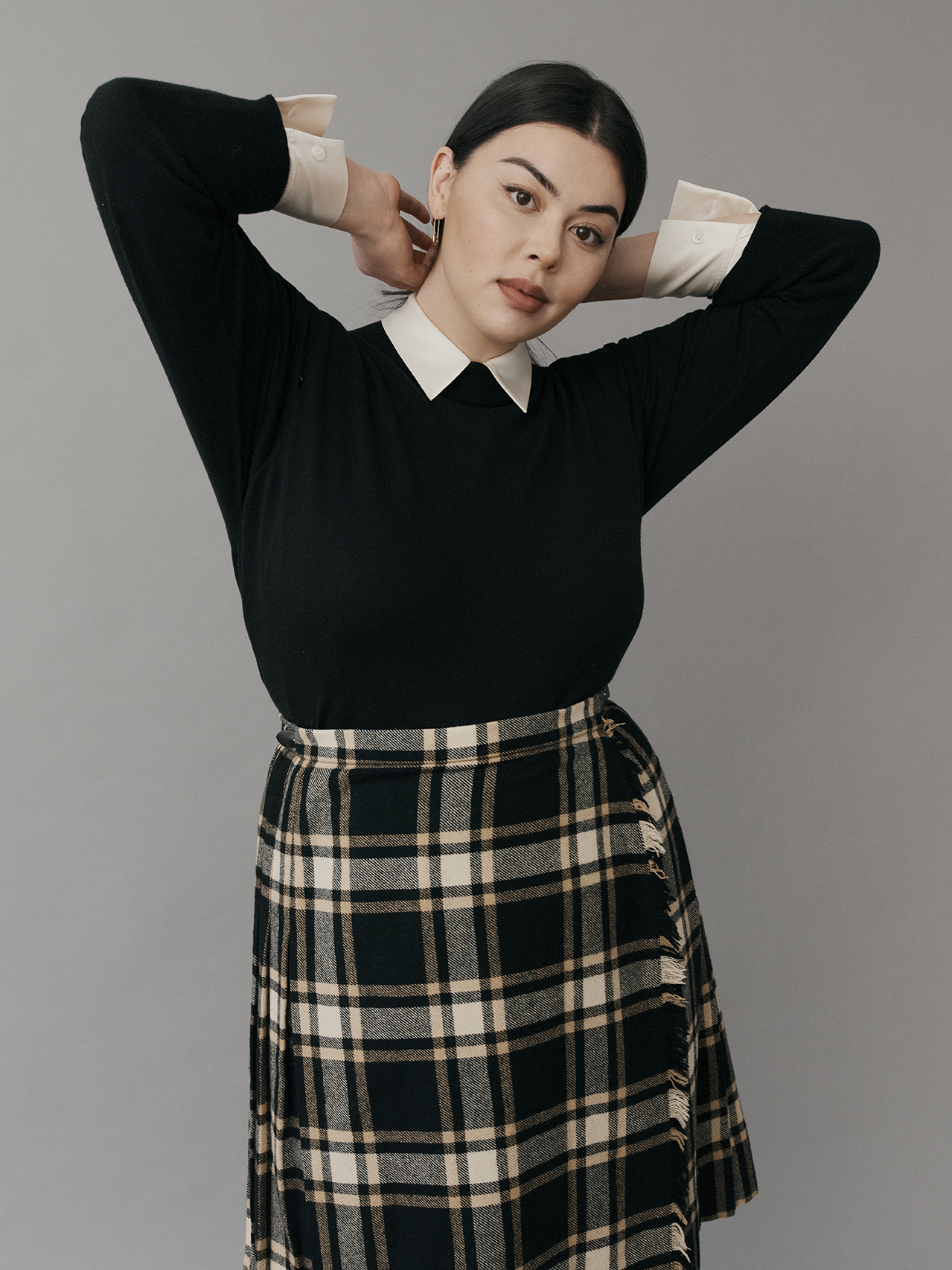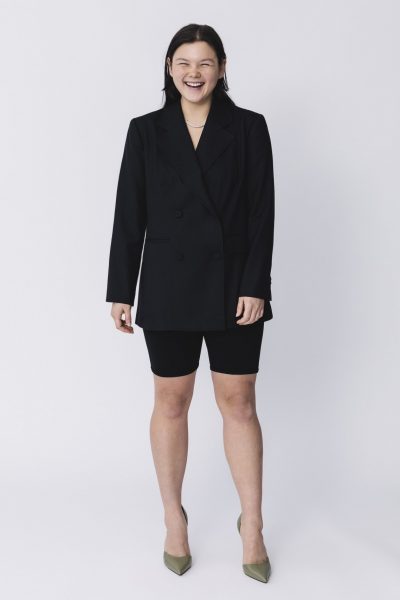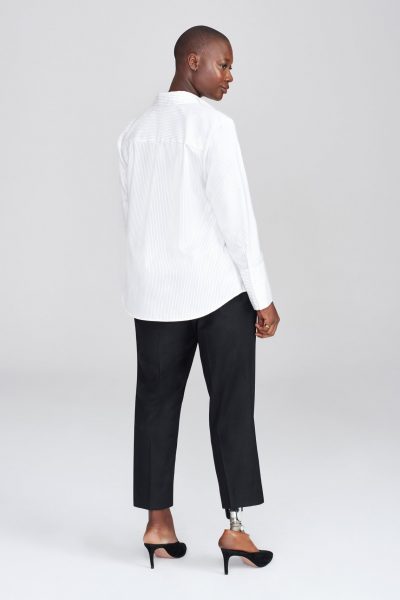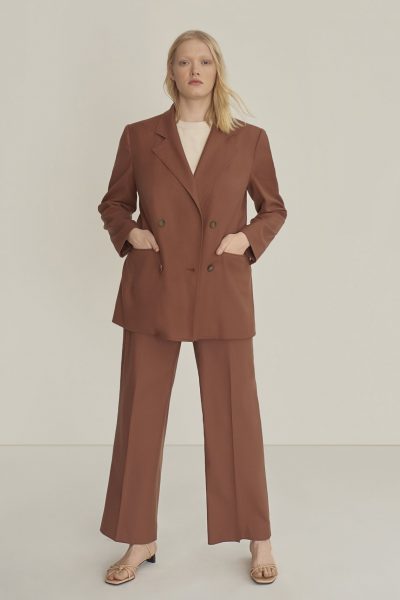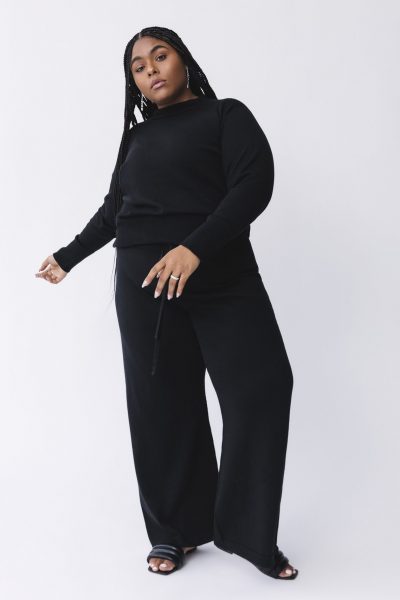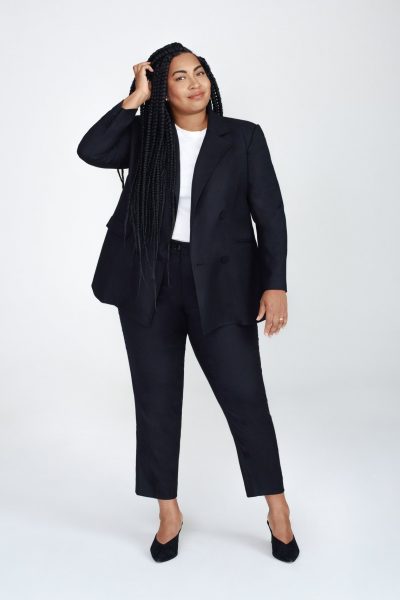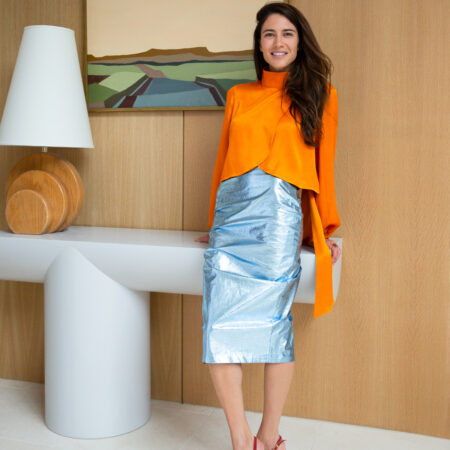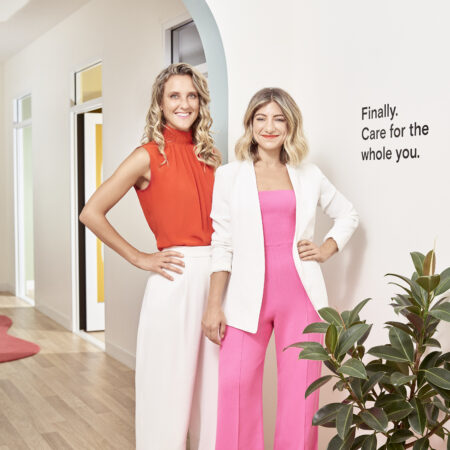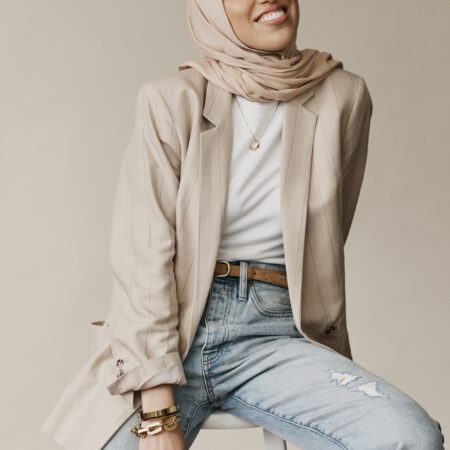From plus-size model to Glamour magazine editor, and now, founder and CEO of Henning, a direct-to-consumer brand specializing in luxury staples for women in sizes 12 to 26, Lauren Chan has worn many hats in the fashion industry. Yet, her mission has always remained the same: advocate for women excluded from fashion because of their size.
In the fall of 2019, just six months before the first COVID-19 lockdowns began, Henning unveiled its debut collection, sustainably made in New York, to much fanfare. Ahead of its official launch, Chan spent months building Henning’s community on Instagram and Facebook. She utilized social media to see what plus-size women were missing in their wardrobes, posing questions about fit and size, and was fully transparent about the design process. The result? A community-based, purpose-driven brand that, despite being known for its impeccable workwear tailoring, managed to pivot quickly when many turned to loungewear during a global pandemic.
During the Year of Many Challenges and Business Obstacles (her first year as a CEO, nonetheless), Chan proved that the most important thing a fashion brand can be is human. Now a one-woman show building the business she bootstrapped, Chan is leaning into what she set out to do—create an inclusive brand that drives change in an industry that desperately needs it. Here, Chan shares how to balance purpose with profit, the lessons she’s learned as a first-time CEO, and how she’s educating consumers on sustainability.
You’ve been vocal about fashion’s lack of size-inclusivity for years. When did you decide to combat the problem by launching your own brand?
In 2018, a few months after I left my job as an editor, I decided to do it. Originally I thought I would work on some type of technology or consultancy to help brands expand sizes at scale, but I realized that I knew nothing about that; I wasn’t the person for that business. However, because of my experience in content, modeling, and design, spreading out my expertise into a brand of my own was a better fit for me.
How did the last year during the pandemic affect your outlook as a founder and CEO? What pivots have you had to make along the way?
Specifically, because we were making tailored pieces, the biggest effect was the downturn of customers shopping for items such as blazers and trousers. It’s all related: in addition to people not working as much, losing their jobs, and not having the same disposable income.
We took two seasons off [from production] and did a single product drop last holiday, which we had never done before. We made that from 100 percent local deadstock and photographed it really scrappily on a much tighter budget, so that was also new for us. In a way, it was less expensive, easier, and more sustainable. For this spring, I changed our loungewear manufacturing to be knit on-demand here in New York City as an effort to preserve cash flow as a result of the past year—but also an effort to increase sustainability. It also expanded our product range (we were not doing loungewear before), and we likely would not have because we were focused on tailored staples and outerwear, etc.
Shop Our Favorite Looks from Henning
What did the pandemic teach you about how you want to sell fashion moving forward?
To be honest, we took such a huge step away from “selling fashion.” I have the luxury to do that as a founder who owns my own business. During the past year, there were more important things happening than fashion. We’re still in the thick of a race revolution, we’re still in the thick of a global pandemic, and all of the after-effects of those two huge turning points in history. It felt selfish to post on Instagram to buy a blazer for 20 percent off. Of course, we have obligations, and we still did that to an extent, but our focus—all of our content and marketing and how we talked to people was really on being human and transparent and encouraging them to work on their allyship and donate extra funds, instead of buying fashion. If they still wanted the fashion, we were donating a portion of our proceeds to organizations that we care about. While we were still selling clothes, my focus as a founder shifted away from just selling fashion. I hope that fashion as a whole will keep that sentiment intact.
The hit we took on revenue last year was industry-standard given the challenges of the pandemic. I figured that if sales were going to be down anyway—because our supply and manufacturing chains were down, retailers stopped buying new products and canceled future orders, et cetera—I wanted to put our efforts towards messaging I cared deeply about rather than trying to frantically sell our remaining stock.
How have you managed to embody purpose-driven leadership while still running a profitable business?
I’d wager that we were already in the top five percent of purpose-driven companies from the start. The extra passion that I picked up along the way was sustainability once my eyes were opened to the real backend of the garment-making industry. The most notable and jarring thing to me was the cost of making garments and how expensive it is to buy good fabric—which I believe is the right choice both performance-wise and environmentally. To have detailed garments like blazers manufactured fairly and locally (meaning adhering to labor laws) is so incredibly expensive. Our retail prices should actually be much higher if we wanted to meet industry standard retail margins, which are at least 80 percent, but we don’t have to do that because we don’t work with traditional retailers. However, it does affect us if a potential retail partner approaches us and our margins aren’t high enough.
There was a price that I knew people would balk at, but still, $595 for a blazer is expensive. When I say we sell things as affordably as we possibly can, we do. After learning all of this, when I shop as a consumer and see $19 blazers, my hair stands up on my neck because if you break that $19 price down in the way that we break our $595 price down, you’re probably looking at $1 in labor, maybe $1 in fabric because rest assured, they still have their margins up 80 percent so that was very worrisome to me. That is not explained to the customer. Customers have no idea what standard margins are. They have no idea what it costs to make a garment, they have no idea about labor laws, or how cheaper fabric can be poisonous.
"The way to make purpose-driven equal profitability is a simple formula: you have to be a very human and transparent brand."
I was a fashion writer and editor for years and still did not have this information, I was not armed with this information until I was actually in the factories and at the mills negotiating pricing and seeing what went on behind the scenes. We don’t want to be the bearers of bad news, and we don’t want to condemn people for consuming fashion. We want to educate the consumer in a way that interests them, is not condescending, and doesn’t entirely turn them off from the product we’re trying to sell.
The way to make purpose-driven equal profitability is a simple formula: you have to be a very human and transparent brand. You have to have someone in charge that is a person and genuine. You have to put resources into customer education, whether about fabrics that we’re using or fit or where the items are made. Balancing these two sentiments has to touch every part of the business, even down to the designs. It helps that we make staples that are well-made and won’t go out of style—we’re not trying to drive more affordable trend items. When brands decide out of nowhere to find a purpose or that they want to be transparent but they haven’t been, it’s impossible to do if it hasn’t been part of the brand from inception or it doesn’t touch every part of the brand—customers these days are very smart. They have so many resources to find the truth about any brand, what they make, how they make it, and who’s behind it.
Between fighting ongoing issues of racism to the effects of the pandemic as a whole, many people have felt completely burned out this year. How have you managed to stay motivated as a CEO?
In a way, all the stress of the past year has re-motivated me. Henning is intensely purpose-driven, and not only do I still believe in what I set out to change, I believe in it more so now. We need plus-size women, specifically plus-size women of color, to be represented in fashion. If big brands are closing their plus-size divisions as a result of downturns in their financial plans, we need independent plus-size businesses to survive and offer varied assortments so plus-size women can express themselves in fashion. More businesses should be setting examples and trying to push sustainable manufacturing so that 5-10 years from now, it’s the norm.
The past year has made what was bad worse and what was promising necessary. When you boil it down that way, anybody who cares about what I care about would be reignited. Now is the time to fight.
You began as a workwear brand focused on tailored staples. Obviously, the way we work and dress for work has changed dramatically. How did the brand change to reflect that?
I was looking at the market, trying to find things in my size, and it was all affordable cotton crewneck sets, but nothing that made me feel as luxurious as my other Henning tailored pieces did. So our take on loungewear is machine-washable cashmere, its viscose antimicrobial masks, and shorts. We’ll find a way to change for whatever comes next, but we will do it with the same values our brand adheres to.

What’s the biggest lesson you learned in the first six months as an entrepreneur?
Oh my gosh, I learned a lesson every day, if not every hour. On a business level, before I started, I was pitching the business to an investor, and they asked me how I was going to make the business succeed. I outlined all of the reasons why I thought I was the best founder in this category, why I thought I would have the best product, why I, in my opinion, have the best network. And still, at the end of my answer, they said, ‘But how are you going to make the business work?’ I thought I had answered that question, and I realized, six months in, that I had not even started to answer that question.
There is a very big difference between the reasons why you have a great idea and how you build a good business. It’s a very steep learning curve. Now, I would answer that investor’s question by saying that we make timeless, seasonless products to curb concerns with fashion’s fast-paced trend cycle. We have an on-demand manufacturing strategy that maximizes cash flow and agility with product-market fit. We have sold clothing via strategic retailers like 11 Honoré, which focuses on plus-size luxury retail. We have collaborated with shopping-focused platforms like Pinterest (you can find us in this month’s The Goods campaign, wherein brands like Henning, Billie, Outdoor Voices, and Maude made an exclusive product). We boast the best customer service in our industry by offering studio try-on visits, and free tailoring (you can send us a receipt for an alteration on a product, and we’ll refund your payment method). Acquisition-wise, we have sought out specific trade shows and events (including Politico and The Curvy Con) to sell in-person to our customers. Online, we have curated a high-converting influencer ambassador and celebrity program that’s featured women such as Ashley Graham, Stacey Abrams, Nicolette Mason, Katie Sturino, in addition to running a lean social advertising program.
You didn’t take on any venture funding for Henning. How did you initially fund the company and learn the financial ropes?
We’re bootstrapped, I put my savings into the company and we did a small friends and family round of funding. [Editors note: Lauren declined to say how much she saved and raised.] For any funding strategy, you have to back into it based on what you need to spend. For us, that was obviously production and website, and you build your financial model from there. And if you have entrepreneurs in your life or within a few degrees of your life, ask them! Women founders have been so incredibly helpful to me in my journey, very forthcoming, very helpful. We all have the ability to do these things within us, but sometimes it takes a little bit of encouragement or an example, or just a vote of confidence, knowing that someone has done this before. Lean on the people around you!
Before launching Henning, you crowdsourced for customers’ sizing and measurement needs on social media. How did that feedback and data help shape your brand?
What was special about that time was that I got to spend six months building a community and talking to people about their wants and needs and their bodies and their closets without selling them anything. (At this point, I was living on the income from my other creative projects and my savings.) That’s special because while we still have that community aspect now, there is an element of making a sale at the end of the day. Even if it’s not explicit, the vibe is underlying, and so the women who are a part of the community from that time are some of the pillars of the community. They’re our super fans, our advisors, our friends. I still ask their opinion on things.
"We’re still in the thick of a race revolution and a global pandemic. It felt really selfish to post on Instagram to buy a blazer for 20 percent off."
I did have a problem once where I was working on the first set of blazers, and I got the sample back and realized that the armholes were too high and production was supposed to be starting the next day. I was panicked because I was about to send jackets to production that were essentially wrong or not up to the bar that Henning set for us. So I went on the Facebook group and the Instagram account and was like, “Please guys, I need your help. Measure your armholes for me; tell me where it should fit.” The response to that was so surprising and so uplifting. It taught me a few things: one, I don’t have to steer the ship by myself, I can just ask. If I’m making blazers for these women, why don’t I ask them what their measurements are? And two, I am so grateful that we have this community because I know that if I’m just a transparent human being and not a faceless corporation, that even when we do make mistakes there’s always a solution. It was a good lesson in perspective—had I sent those incorrectly into production, we would have offered tailoring credits to fix them. There’s always an answer.
Is there anything you know now that you wish you knew five years ago?
Oh, my gosh. Five years ago, where was I? I was a fashion journalist at Glamour, and I wish that I had done a little more reporting and educated myself more on the supply chains of fashion brands, on the financial structures, on the business practices. I, of course, have learned a lot about those things since building my own business. However, it would have been nice to have time to study those things from afar.
As someone who didn’t have prior business experience in this capacity, what has been the greatest challenge in learning how to build your own company?
The volume of work, to be quite honest. If you were like me, you would be going from working in a corporate environment where you have your job duties and tasks, and other staff members have their job duties and tasks that either support your role or work in tandem with it. When you start a business, you are everyone, and you do everything, and you have to figure it all out. For me, that’s been learning accounting software, learning Photoshop, figuring out how clothes get made, what a tech pack is, and how to design garments. You are learning every day, you are getting new skills, you are meeting different types of people. It’s very overwhelming.
What’s one piece of advice you would give to women looking to start their own company?
Don’t rush. Of course, you want to get to market. Rushing is often caused because you’re looking around comparing yourself to other people, and that should never be the reason for you to make a decision. Also, do your research, get to the library, ask people who’ve done it before, watch tutorials on YouTube, shadow somebody else in their job, walk through a factory if you’re going to be making a product, take your time and really understand your potential business and market and go from there.
What does the future of Henning look like?
Continuing on the path that we are. Right now, our knitwear is made on-demand and our tailoring and outerwear will follow that path next. More of what we’ve always been doing—more representation, better quality products.
